|
Printables |
PowerPoints |
Online exercises |

|
A2+-B1 Gerund or infinitive practise 1
Learning the difference between gerunds and infinitives is essential for achieving accuracy and fluency in English. Gerunds (verbs ending in -ing, like "swimming") and infinitives (the base form with "to," like "to swim") often have specific rules or conventions that dictate their use, which can change the meaning of a sentence. For example, "I sto...
Level: intermediate
Age: 8-100
Type:
Downloads: 114
|
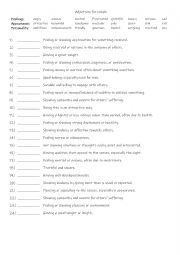
|
A2+-B1 8 adjectives for each - feelings - appearance and personality
Learning vocabulary for feelings, appearance, and personality enables clearer and more expressive communication. Words for emotions like "anxious" or "excited" help us convey our moods and understand others better, strengthening relationships. Descriptive terms for appearance, such as "slim" or "muscular," are useful for identifying people, setting...
Level: intermediate
Age: 8-100
Type:
Downloads: 112
|
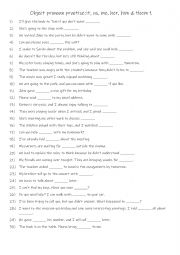
|
A1-A2 Object pronoun practise: it, us, me, her, him & them 1
Practising object pronouns like it, us, me, her, him, and them is essential for building clear and natural sentences in English. Object pronouns replace nouns to avoid repetition and make sentences smoother, which is crucial for effective communication. By mastering these, you can better describe actions involving people and things, making everyday...
Level: elementary
Age: 7-100
Type:
Downloads: 112
|
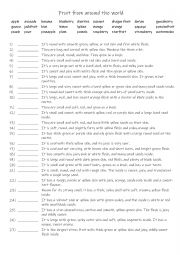
|
A1+-B1 Fruit from around the world
Learning definitions for fruit names from around the world is valuable because it broadens vocabulary and cultural understanding, enabling you to communicate effectively about food, nutrition, and travel. Recognising these fruits by name helps you read menus, understand recipes, and make informed choices when shopping or eating in diverse settings....
Level: elementary
Age: 8-100
Type:
Downloads: 111
|
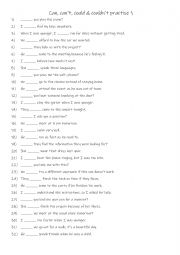
|
A1 Can, can�t, could & couldn�t practise 1
Practising "can," "can�t," "could," and "couldn�t" at the A1 level is essential for basic communication, as it enables you to express ability, permission, and possibility. These modal verbs allow you to talk about what is possible now or was possible in the past, which is vital for forming complete sentences and polite requests. Mastering them ...
Level: elementary
Age: 7-100
Type:
Downloads: 106
|
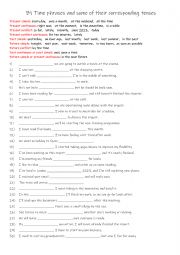
|
B1 30 time phrases and some of their corresponding tenses
Learning time phrases and their corresponding tenses at this level is important because it improves clarity when discussing when actions happen. Each tense communicates a different aspect of time, like regular routines, ongoing actions, completed events, or future plans. For example, using "every day" with the present simple helps describe habits, ...
Level: intermediate
Age: 9-100
Type:
Downloads: 108
|
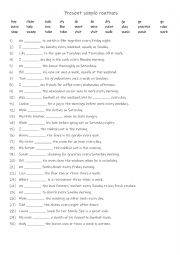
|
A1+-A2 Present simple routines + 3rd person practise
Learning present simple routines with these verbs is useful because it helps describe everyday actions in English, which is important for basic conversation. The present simple tense is used to talk about habits and routines, so knowing these verbs allows students to share information about daily life, like "I wash dishes every evening" or "She vis...
Level: elementary
Age: 8-100
Type:
Downloads: 129
|
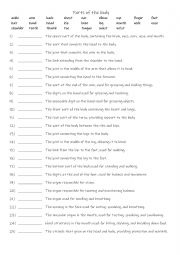
|
A1+-A2 25 parts of the body definitions
Learning these 25 body parts and their definitions is helpful for basic communication about health and daily activities. Knowing the names of body parts allows students to explain how they feel, describe symptoms to doctors, and understand instructions related to movement or health care. These words are also common in simple conversations and expre...
Level: elementary
Age: 8-100
Type:
Downloads: 117
|
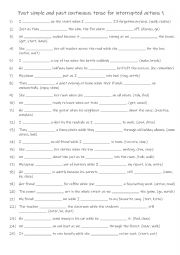
|
A1+-A2 Past simple and past continuous tense for interrupted actions 1
Learning the past simple and past continuous tenses for interrupted actions is essential because they help students describe events that were happening in the past when something else occurred. The past continuous is used to show the action that was in progress at a specific time in the past, while the past simple is used to describe the action tha...
Level: elementary
Age: 8-100
Type: worksheet
Downloads: 116
|
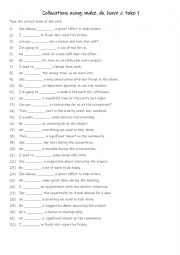
|
A2-B1 Collocations using make, do, have & take 1
Learning collocations with make, do, have, and take is important because they help you speak and write more naturally and fluently in English. These verbs often pair with specific nouns or phrases, and using them correctly improves your communication. For example, "make a decision", "do homework", "have a conversation", and "take a break" are commo...
Level: elementary
Age: 9-100
Type:
Downloads: 109
|
|
|
|
|












